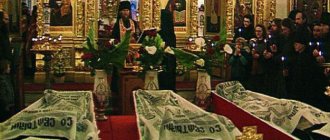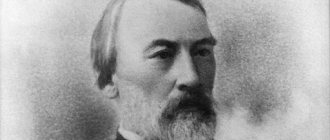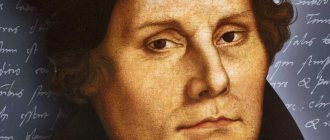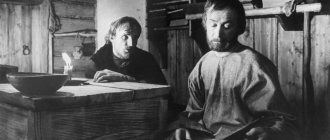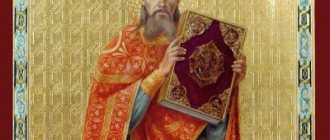The question often comes up on Orthodox websites: how is a monk different from a monk? The fact is that in Russia these two concepts have always been considered synonymous words. All pre-revolutionary dictionaries talk about this.
At the same time, many Russian Orthodox monasteries insist that a monk and a monk are different degrees of monasticism. However, both the monk and the monk are engaged in the same thing - they wage spiritual warfare to the death. Their weapons are different, depending on the vows they have taken.
In order to understand who monks are, it is necessary to study the degrees of Orthodox monasticism
It is impossible to understand who monks are without studying the degrees of Orthodox monasticism, since monasticism in our time is one of them. The degrees of monasticism are the stages that Orthodox monks or nuns go through during their stay in a monastery.
Icon. It depicts the vestments of a newly converted monk - monastic robes. Previously, the concept of “monk” and “monk” did not differ
A monk in a monastery must change his thoughts from passionate to virtuous. To achieve this, he takes vows. A vow is a promise made by a Christian.
In the Orthodox Church, monastic vows are fulfilled for life before God. That is why they are not given lightly; vows have degrees from simple to complex. Traditionally, in the Russian Orthodox Church, a novice undergoes a trial (test). If passed successfully, three degrees of monasticism are opened.
The difference between the degrees is in the number of vows taken before God, ascetic rules of behavior, obedience, and also in monastic robes.
The degrees of monasticism and its concept are enshrined in a special provision of the Russian Orthodox Church.
As for the official consolidation of the concept of “monasticism” in the Russian Orthodox Church, the Russian Orthodox Church adopted for this purpose the “Regulations on Monasteries and Monastics.”
It says:
“Regulations on monasteries and monastics” on pravoslavie.ru
“Monasteries are governed and live in accordance with the provisions of this Charter, the Civil Charter, the “Regulations on Monasteries and Monastics” and their own Charter, which must be approved by the diocesan bishop.”
That is why in different monasteries, while following general rules, the position and status of a monk or nun may vary.
Adoption on November 30, 2021 by members of the Council of Bishops of the Russian Orthodox Church of the Regulations on Monasteries and Monastics. The Regulations establish monastic levels in the Russian Orthodox Church and regulate monastic life.
The regulations determine the basic principles and rules of life of the Russian monasteries and on its basis the rules of monastic life in a particular monastery are established: routine of life, schedule of services, features of obedience, etc.
It should be noted that the Regulations use only the terminology that applies exclusively to male monasteries: abbot, brotherhood, brother, monk, monk, novice. With the exception of strictly specified cases, all statements of the Regulation also apply to abbess, sisterhood, sister, nun, nun, and novice. Thus, in terms of her position, a nun is practically no different from a monk.
Etymology of words
Let's start with the fact that the concept of “monk” is a Church Slavonic concept. His education is quite interesting. This is a special tracing from the Greek word monachos. “Monos” means “one”, like the Old Russian “in” - “one”. And achos is translated as “living, existing.” In Church Slavonic, one who lives and exists sounds like “ok”. So it turns out that the word “monk” is of Russian origin, but its meaning is consonant with the Greek word “monachos”.
In our Russian language, the word “monk” came from Greek. And at first they had the same meaning. But later they separated.
There are six degrees of monasticism in Orthodoxy
Almost everyone who enters the monastery, except for the trudnik (trudnitsa), novice (novice) and ryasophore novice (novice), takes monastic vows. Monastic tonsure is understood as a vow of renunciation of the world, since monasticism is a special way of Christian life, which consists in completely dedicating oneself to the service of God.
In addition, a monk or nun also takes the following vows for the love of Christ: obedience, virginity or chastity, and non-covetousness. During the rite of tonsure as a monk, a person's hair is symbolically cut. In addition, he is also given a new name, chosen in memory of the saint who becomes the patron of the tonsured person.
tonsure
vow of renunciation of the world
Some monasteries have developed six degrees of preparation for monasticism:
- worker (worker).
- novice (novice).
- Rassophoran novice (Rassophore novice).
- monk (nun).
- small schema (monk/nun.
- schema or great schema (schema-monk, schema-monk/schema-monk, schema-nun).
It should be noted that in any case, a monk is obliged to fulfill his main service in the Church - constant presence in communion with God and prayer for the whole world. Monks preach the gospel of Christ through their living example of active repentance, love for God and service to Him.
Monasticism is based on the words of the Lord Jesus Christ:
“If you want to be perfect, go, sell your possessions and give to the poor; and you will have treasure in heaven; and come and follow Me.”
Mf. 19, 21
Thus, it is not a product of human thought, but of the Will of God.
Novice and ryassophore are those degrees of monasticism that precede monasticism
Before becoming a monk and then a monk, those entering the monastery are required to go through two stages: novice and ryassophore. A novice or novice is a person preparing to become a monk.
Despite the fact that the novice and novices do not take monastic vows, they already belong to the monastic brotherhood. However, they do not wear a cassock - monastic clothing; they are only allowed to wear a cassock.
Novice
a person who is preparing to become a monk
The main task of a novice or novice is to prepare to become a monk, as well as to perform various obediences at the monastery. Living in the monastery, they get used to the daily routine and monastic rules, to monastic life.
In the Russian Empire there was a rule according to which a novice had to live for at least 6 years in the status of a novice in a monastery before he could take monastic vows and become a ryassophore.
A cassock (cassock novice) is understood as a person who is allowed to wear a cassock. In Greece, this degree is called the “Rassophore novice” (“Rassophore novice”), while the Greeks themselves consider this degree to be a stage of novitiate (preparation for monasticism). Ryasophorus is allowed to wear a cassock, kamilavka (skufya) and rosary.
You can't become a priest
I was born into a pious family. Mom and grandmother took us, three sisters, to the temple. Sometimes, of course, I wished that the service would end quickly so that I could go home and play. But that's how we were raised. Before going to bed, we read the lives of saints and divine books.
When I was very little, my grandmother and I went to the Intercession Cathedral. I saw a clergyman and said: “When I grow up, I will become a priest.” The grandmother explained that this was impossible for a girl. Then I said that I would work on candles - for free, I don’t need anything. When many years later I came to the monastery, I was actually assigned such obedience.
The word “monk” (“nun”) is of Greek origin, “monk” is of Russian origin.
Old dictionaries and encyclopedias claim that the words monk, monk, monk are synonymous words. The Brockhaus and Efron Encyclopedic Dictionary puts it this way:
“Monk is the same as a monk, actually “lonely” (monk), a direct translation of the Greek monahos.”
The meaning of the word monk is different for church and secular literature. The fact is that writers can call any person living in a monastery a monk, while modern church tradition calls this only those who have received the right to wear certain monastic robes.
Konstantin-Eleninsky convent. He was tonsured into the ryassophore. Consecration into the ryassophore (the first stage of monasticism) can only be carried out on a person who has been in the monastery for 3 years
The Regulations on Monks and Monastics states that tonsure into the ryassophore can only be performed on a person who has been in the monastery for 3 years. This period is reduced for students of theological seminaries.
A person remains in the rank of monk or monk until he is tonsured into the “minor schema.” The minor schema means the final acceptance of monastic vows, as well as the naming of a new name. Thus, the monk becomes, as it were, a “novice” monk.
Many nuns, having accepted monasticism, do not accept subsequent monastic degrees and spend their entire lives in the monastery in this degree of monasticism.
Notes
- Handbook for a clergyman: TRANSMISSION TO MONACHISM - Sequence of the robe of the cassock and kamilavka. In 8 volumes. -M.: Publishing House of the Moscow Patriarchate, 1993-1994.
- Samuilov V.
Ryasofor. (Historical information) // Additions to the Church Gazette. - 1905. - No. 42. - S. 1784-1789. - Babkin M.
Will monks be allowed to get married? // NG-religions, 07/16/2014. - Priest
- Handbook for a clergyman: THE SACRAMENT OF THE PRIESTHOOD (ORDINANCE) - Degrees of the church hierarchy. In 8 volumes. -M.: Publishing House of the Moscow Patriarchate, 1993-1994.
- not tonsured into the mantle, he will not have the right to wear the bishop's mantle of purple, blue or green colors with white and red sources.
- monk - Wiktionary (Russian). ru.wiktionary.org
. Date accessed: May 24, 2021. - Etymology of the word monk (Russian). ΛΓΩ
. Date accessed: May 24, 2021. - Handbook for a clergyman: TRANSMISSION TO MONASKHIP - Following the minor schema, or mantle. In 8 volumes. - M.: Publishing House of the Moscow Patriarchate, 1993-1994.
- Handbook for a clergyman: TRANSCRIPT - Monastic vows. In 8 volumes. - M.: Publishing House of the Moscow Patriarchate, 1993-1994.
- Handbook for a clergyman: TRANSMISSION TO MONASKHIP - The rite of tonsure into the great schema. In 8 volumes. -M.: Publishing House of the Moscow Patriarchate, 1993-1994.
- Monasticism as a Sacrament of the Church: Russian Orthodox Church. Department for External Church Relations
Monks, unlike monks, accept the small and great schema
If a monk is going to advance further on the path of monasticism, he becomes a monk, first accepting the small and then the great schema.
At the same time, the division into the small schema and the great schema is not recognized in all Orthodox churches. So, for example, the Greek Orthodox churches have only the ryasophore tonsure and immediately the vow of the great schema.
Clothes of a monk who has accepted the minor schema. Robed monks make up the majority of monastics
The second name of the small schema is mantle monasticism. By taking monastic vows and the vows of the minor schema, a person completely renounces worldly life and becomes a monk. He receives a new name, as if being born again, and at the same time makes the following vows:
- Obedience , that is, renunciation of one’s personal will and complete obedience to one’s confessor;
- Celibacy or chastity;
- Non-acquisitiveness or poverty, that is, refusal to own personal property.
In total, monks are obliged to observe the vows given at baptism, ascetic vows, as well as daily observe the prayer rule laid down in the monastery and by the confessor and carry out monastic obedience, that is, work in the monastery.
The monastic elects the leader of his spiritual life, the elder, and vows to follow his advice and will in all his affairs. Usually, tonsure into the minor schema occurs at the liturgy and after it the new monk is solemnly dressed in a tunic, paraman, cassock, mantle (pali), hood, sandals, and a rosary is given to his hand.
His Holiness Patriarch of Moscow and All Rus' Kirill. Patriarch Kirill - robed monk
Robed monks are the majority among monastics. That is why they are usually understood as Orthodox monks in general. Only monastic monks can occupy the highest church positions, for example, being abbots and governors of monasteries, ruling bishops, including His Holiness Patriarchs.
In Rus'
"Reverend Anthony and Theodosius of Pechersk." Saida Afonina. Fragment
The first monastery of Kievan Rus arose under Prince Yaroslav Vladimirovich, this is the Kiev-Pechersk Monastery. We owe its appearance to Saint Anthony and Saint Theodosius of Pechersk, who became the first abbot and founder of monasticism in Rus'.
In the period before the Mongol invasion in Rus', several large monastic centers developed in Kyiv, Novgorod, Chernigov, and other cities. Monasteries were not only centers of piety and spirituality, from here literacy and the arts, including chronicle writing and icon painting, spread.
After the Mongol invasion, the center of spiritual life moved to northeastern Rus'. Here, in the deep forests, monasteries arose that became centers of national identity, storing ancient books and continuing the traditions of chronicle writing. The brightest light of monastic asceticism of this period was St. Sergius of Radonezh, who founded the Trinity-Sergius Lavra, which to this day remains the main spiritual center of modern Russia.
Until the era of Peter I and his reforms, monasteries in Russia remained a place of intense spiritual, intellectual and political life. Schools were founded here, books were created, icons were painted here. Here, polemics took place between representatives of different directions of religious thought - between the “Josephites” and the “non-covetous”, between supporters of Nikon’s reforms and those who adhered to the old rite.
During the period that in church history is called the “Synodal” period, the importance of monasteries especially increased. In a situation where parish priests were almost equal to other government officials, people reached out to the monks, seeing in them the guardians of ancient piety. At this time, eldership arose and flourished; Optina Pustyn was especially famous for this.
After the October Revolution of 1917, the vast majority of monasteries were destroyed, many monks were thrown behind bars or shot, the rest had to hide. However, after 1991, monastic life in Russia was revived.
A monk cannot accept the great schema
The highest degree of monasticism is the great schema. The difference between the small and great schema is indicated in the Regulations of the Russian Orthodox Church on monasteries and monastics. According to him, the great schema means complete alienation from the world for union with Christ.
Otherwise it is called the great angelic image. In common parlance, a schemamonk is called a schemanik. A monk cannot become a schema monk without first accepting the minor schema.
A monk who has accepted the great schism in full robes. The Great Schism is the highest level of monasticism
During the adoption of the great schema, the monastic takes special vows and again changes his name. Thus, he has a second patron saint. In Russian Orthodox monasteries, Great Schema monasteries usually live separately from other monks and, apart from unceasing prayer, do not engage in any other obediences. All those who have accepted the great schema strive to live in seclusion, without contact with other people.
The great schema-monk dresses in special clothes: a cassock, a cassock, analav (a special kind of paraman), a kukol (a pointed cap with crosses), a mantle, sandals, a belt and a tunic, he also wears a rosary.
In the modern practice of the Russian Orthodox Church, the great schema is a very rare phenomenon: as a rule, elderly or seriously ill monks who do not carry out the usual monastic obediences are tonsured into it.
Literature
- Monasticism // Encyclopedic Dictionary of Brockhaus and Efron: in 86 volumes (82 volumes and 4 additional). - St. Petersburg, 1896. - T. XIXa. — P. 714—733.
- Monk // Encyclopedic Dictionary of Brockhaus and Efron: in 86 volumes (82 volumes and 4 additional). - St. Petersburg, 1894. - T. XIII. — P. 222.
- Test for persons wishing to enter monasticism // Encyclopedic Dictionary of Brockhaus and Efron: in 86 volumes (82 volumes and 4 additional). - St. Petersburg, 1894. - T. XIII. — P. 459.
- Polskov K. O., priest.
Monastic tonsure as a sacrament of the Church // Materials of the V International Theological Conference of the Russian Orthodox Church “Orthodox Teaching on Church Sacraments.” Volume 3. - M., 2009. - Domnika (Korobeinikova), abbot.
About the ryassophore as the initial degree of the monastic order // Journal of the Moscow Patriarchate. 2012. - No. 10. - pp. 38-43 - Hilarion (Alfeev), Metropolitan.
Monasticism as a Sacrament of the Church // Monasteries and monasticism: traditions and modernity. International theological scientific and practical conference at the Holy Trinity Sergius Lavra. - M.: Synodal Department for Monasteries and Monasticism of the Russian Orthodox Church, 2013. - 224 p. - Uspensky B. A., Uspensky F. B.
Monastic names in Russia. - M.: Institute of Slavic Studies of the Russian Academy of Sciences; SPb. : Nestor-History, 2021. - 344 p. — ISBN 978-5-4469-0000-0.
In our time, the differences between a monk and a monk are very significant
If previously any monk was called a monk or monk, in our time this concept refers exclusively to a person tonsured into the ryassophore. What is the difference between a monk and a monk is directly stated in the “Regulations on Monasteries and Monastics.” According to him, monasticism is the first stage of monasticism, but someone tonsured into the ryassophore is not yet a monk. The Regulations say this:
“Monasticism (ryasophore novitiate, ryassophore). If this is provided for by the internal regulations of the monastery, with the blessing of the diocesan bishop and with the voluntary written consent of the novice, a special rite of vesting the latter in a cassock and hood with a possible change of name can be performed. Leaving the monastery by the monks of the ryasophores is a canonical crime and is punishable by penance, determined by the diocesan bishop on the recommendation of the abbot.
- Monastic tonsure
The probationary period through which novices go is not limited to the above-mentioned three-year period and can be extended by the sole or joint decision of the Abbot of the monastery with the Spiritual Council...”
“Regulations on monasteries and monastics” on pravoslavie.ru
Enoch. Konstantin Slavitsky. 1897 A monk and a monk are similar in that they serve God and in the fact that they follow the same path of monasticism, only they stand at different levels
A monk does not take monastic vows before God and must fulfill only those vows that he made at baptism. In addition, the clothing of a monk and a schismatic, that is, a monk who has accepted a small or great schism, differs.
A monk takes monastic vows before God. From that moment on, he changes his name, and can no longer just leave the monastery without breaking these vows, which is recognized as a terrible sin. If the task of a monk is to prepare to become a monk, fulfilling obediences and doing mental work, then the schema-monk diligently fulfills his monastic vows in practice and pray to God for his salvation.
By leaving a comment, you accept the user agreement
History of origin
Monasticism originated in Egypt, which at the beginning of our era was one of the provinces of the Eastern Roman Empire. Ascetics who retired to the desert to live far from worldly temptations were known even in the earliest apostolic times. This kind of ascetic practice originates from the biblical ascetics of pre-Christian, Old Testament times.
Useful materials
However, monasticism became a truly widespread phenomenon in the 4th century, from the time of Constantine the Great, who made Christianity the state religion in the empire. The reason for this was the desire to imitate the early Christians, who went to great lengths to affirm and confess their faith.
Founder
Iconography: Anthony the Great, Venerable Dates: XVI century. Second half of the 16th century. Icon painting school or art center: Crete. Material: Wood, gesso, tempera. Dimensions of the icon: height 108 cm, width 63 cm Inv. No. ИVIII 5277 State Historical Museum 53054. © “Historical Museum”
The founder of monasticism was St. Anthony the Great, who lived in the middle of the fourth century. He settled on the banks of the Nile, in strict solitude. However, after some time, other hermits began to come to him, hoping to receive instructions from him. Anthony did not teach, however, he did not forbid people to settle near him, having built his own “cell” of branches.
Interesting fact
This is how the first monastic monastery in the history of Christianity arose, in which monks lived next to each other, but in solitude, practically without communicating, but being connected by a common spiritual feat.
Following this, other desert monasteries began to appear.
Another type of early monastery was the cinenovia - monasteries—
dormitories. Their creator Pachomius the Great, a contemporary of Anthony the Great, also took the experience of early Christians as a model, but not the eremitic, but the communal. The first Christians lived in communities in which property was common, equality reigned, and everyone obeyed one spiritual mentor.
Pachomius the Great, who had the experience of a hermit’s life in the desert, realized that for a neophyte, solitude is not at all useful, but, on the contrary, can be dangerous. Therefore, he created the monastic life as a type of monastic life, in which the main thing is strict obedience and regulation of the entire way of life of each of the monks.
In the 4th century there were hundreds of monasteries of both types in Egypt and Palestine. Basil the Great, having become acquainted with the way of life in these monasteries, created a monastery in his own Cappadocia. He also compiled the first monastic charter, which soon became commonly used for all Eastern monasticism.
Monasteries-dormitories and monasteries-lavras, in which monks live in separate cells located next to each other (lavra from the Greek “town, street”), appeared in the Balkans, in the territory of Asia Minor. Mount Athos was one of the most famous monastic centers of that time. It was from here that monasticism came to Rus'.
